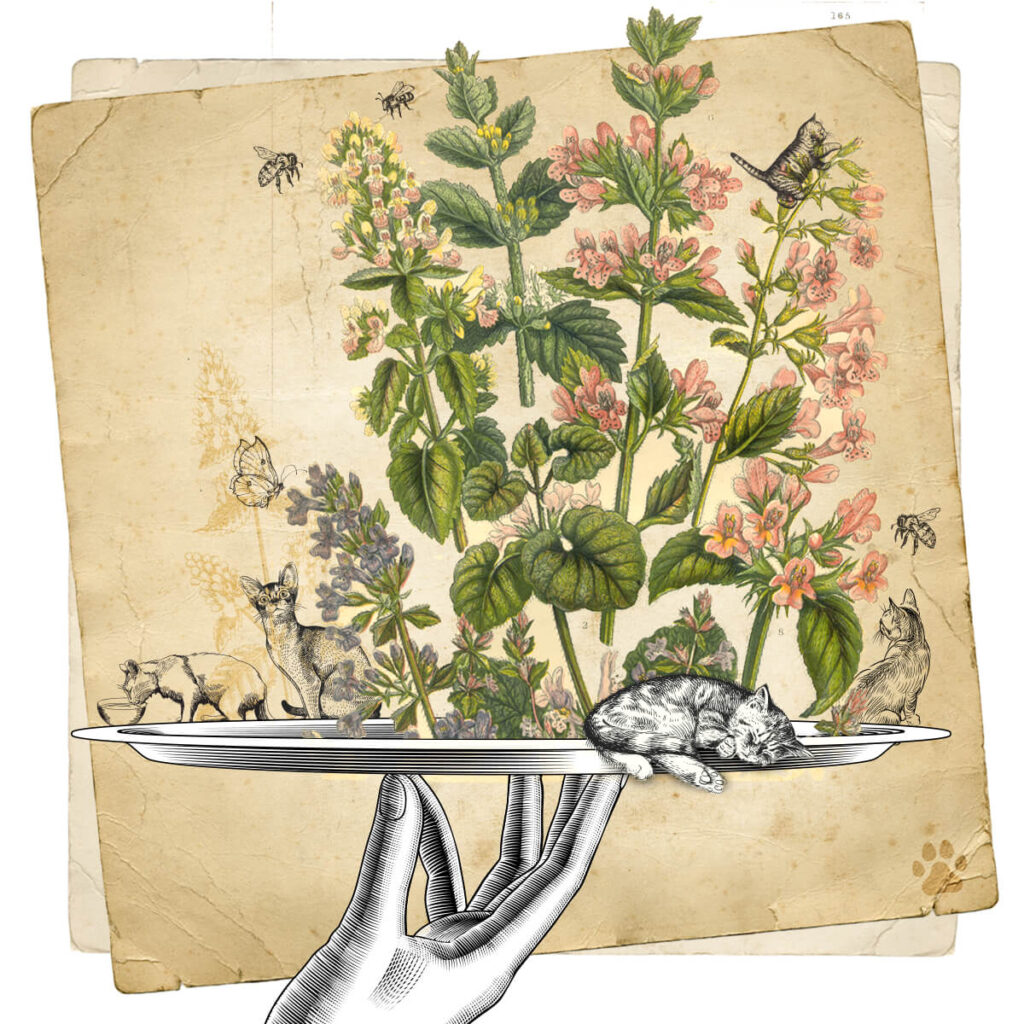The Magic Herb That Connects Nature and Cats
Catnip (Nepeta cataria) has long fascinated cat owners around the world. Whether it triggers rolling, purring, or simply a dreamy gaze, catnip’s power over cats seems almost magical. But behind the fun lies a remarkable natural history that stretches back centuries. Even more fascinating is the biochemical reaction that links cats to this humble herb in an unexpected way.
As spring arrives in the Northern Hemisphere and gardens begin to flourish, it’s the perfect time to discover the deeper story of catnip: where it comes from, how it affects cats, and why planting a little pot of green might just bring pure happiness to your feline companion.
A plant with ancient roots
Catnip belongs to the mint family (Lamiaceae) and is native to parts of southern and eastern Europe, the Middle East, and Central Asia. Over the centuries, it spread widely through human cultivation, and today it grows wild across temperate regions around the world. It thrives in sunny fields, dry soils, and along roadsides, easily adapting to different environments.
Its gray-green leaves, heart-shaped and slightly fuzzy, release their characteristic aroma when brushed or crushed. Delicate white or purple flowers attract pollinators like bees, adding ecological value to gardens. While catnip’s fame today rests mainly on its effect on cats, it was once prized by humans for its soothing, medicinal properties — brewed into teas or applied to relieve minor aches and pains.
The history of catnip and humans
In medieval Europe, catnip was a common part of household herb gardens. People used it to treat a variety of issues, including digestive discomfort, sleeplessness, colds, and even anxiety. Its Latin name, Nepeta, likely derives from the ancient Etruscan city of Nepete in Italy, where the herb is thought to have been first cultivated.
Historical records suggest that cats’ playful responses to catnip were observed accidentally during this period, though not immediately understood. By the 18th and 19th centuries, as cats transitioned from working mousers to cherished companions, offering catnip became a deliberate gesture of affection. Victorian households in England were among the first to grow catnip specifically for feline enjoyment, blending tradition with the emerging idea of the cat as a member of the family.
By the early 20th century, as pet care products gained popularity, dried catnip toys and sprays entered the commercial market. This growing fascination soon led scientists to explore why cats reacted so strongly to this unassuming plant.
The biochemistry of catnip
The magic of catnip lies in a chemical compound called nepetalactone, found in the plant’s leaves, stems, and seeds. Nepetalactone is classified as a volatile terpenoid, a type of organic compound involved in plant defense and communication.
When a cat smells nepetalactone, it binds to specific olfactory receptors inside the nasal cavity. These receptors are tuned to detect pheromone-like substances. In cats who are genetically sensitive, nepetalactone activates several key areas of the brain:
- The olfactory bulb, which processes smell.
- The amygdala, the center for emotion and social behavior.
- The hypothalamus, which controls physiological responses such as sexual arousal and predatory play.
Nepetalactone mimics natural feline pheromones, particularly those associated with mating and social bonding. Rather than triggering a simple smell response, it initiates a complex cascade of neurochemical signals that lead to heightened excitement, playful behaviour, and euphoria.
Cats might display behaviours such as:
- Rolling and rubbing against the source.
- Cheek-marking (scent rubbing) objects.
- Vocalising, purring, or drooling.
- Sprinting, leaping, and playing.
These effects are typically short-lived, lasting about 10 to 15 minutes, after which cats become temporarily “immune” until their receptors reset.
A cat’s superpower: smell and the Jacobson’s Organ
Cats experience the world primarily through scent. Their noses contain up to 40 times more odour-sensitive receptors than human noses, giving them an extraordinary ability to detect subtle chemical signals. In fact, when all factors are considered, a cat’s overall sense of smell is estimated to be about 14 times stronger than that of humans.
In addition to their main sense of smell, cats possess a special structure called the Jacobson’s organ, also known as the vomeronasal organ, located in the roof of the mouth. This specialised organ detects pheromones and other complex chemical cues, sending direct signals to the brain’s emotional and behavioural centres.
When a cat encounters catnip, the nepetalactone molecules stimulate both their primary olfactory receptors and, potentially, the Jacobson’s organ through flehmen-like behaviour, such as open-mouth sniffing. This deep sensory engagement helps explain why catnip can trigger such intense emotional, playful, and euphoric reactions in sensitive cats.
Why some cats react to catnip and some do not
The ability to respond to catnip is genetically determined. Sensitivity to nepetalactone is inherited as a dominant trait, meaning that if a cat inherits the gene from even one parent, they are likely to react.
Studies have shown that about 50 to 70 percent of domestic cats exhibit a behavioural response to catnip, and that this trait is passed down from parents to kittens through basic genetic inheritance.
Several factors influence catnip sensitivity:
- Genetics: Only cats with the right olfactory receptor genes will react. These genes control how their sense of smell recognises nepetalactone.
- Age: Kittens under six months old typically do not respond, even if they are genetically predisposed.
- Health and Mood: Stress, illness, or advanced age can reduce responsiveness.
It is important to remember that a cat who does not react to catnip is perfectly normal.
Differences between age, sex, and breeds in catnip response
While genetics determine whether a cat can respond to catnip, other factors also influence how strong and expressive the reaction is. Studies suggest that age, sex, and neutering status can all play a role.
- Age: Kittens under the age of three months rarely react to catnip. Sensitivity typically begins to appear between three and six months of age as their nervous systems mature. Full adult responses usually develop after six months.
- Sex: Male and female cats may react differently to catnip. Male cats often show more passive behaviours, such as sphinx-like postures, while female cats tend to display more active behaviours like rolling and vocalising.
- Neutering status: Early neutering (before three months of age) has been associated with more passive or reduced behavioural responses to catnip. Hormonal influences during early development may subtly affect how strongly cats respond later in life.
- Breed: At present, no clear evidence links catnip sensitivity to specific breeds. Most studies have been conducted on mixed-breed domestic cats. Further research would be needed to determine whether certain breeds are more or less sensitive to nepetalactone.
All these factors, combined with genetics, help explain why no two cats experience catnip in exactly the same way.
Wild cats and the catnip mystery
Although catnip is loved by domestic cats, it does not grow naturally in the regions where many wild cats evolved, such as sub-Saharan Africa or Southeast Asia. Nevertheless, studies and zookeeper observations reveal that many big cats react to catnip when exposed in captivity.
Leopards, jaguars, and lynxes often show strong catnip responses, rolling, rubbing, and displaying playful behaviour much like domestic cats. Lions and tigers are less consistent; some individuals show intense reactions, while others appear indifferent.
This suggests that the neural wiring for the catnip response is ancient, likely inherited from a common ancestor millions of years ago, even if the plants were absent from their wild environments.
In the wild, lions and other big cats often roll in dust or scent-marked areas, but no equivalent “wild catnip” plant has been identified. These behaviours serve primarily for grooming, parasite control, and communication, rather than pure pleasure.
Catnip is not the only botanical delight for cats. Other plants containing similar active compounds include:
- Silvervine (Actinidia polygama), a climbing plant native to mountainous regions of East Asia, especially Japan and China. It is often considered more potent than catnip.
- Valerian root (Valeriana officinalis), a perennial herb native to Europe and parts of Asia, known for its strong, musky scent that can trigger playful or relaxed behaviour.
- Tatarian honeysuckle (Lonicera tatarica), a flowering shrub native to Siberia and northern China, with wood that can stimulate cats in a similar way to catnip.
Planting catnip: Springtime joy for your cat
As the Northern Hemisphere moves into the planting season, catnip is an ideal addition to any garden, balcony, or windowsill.
Catnip grows easily:
- It prefers full sun and well-drained soil.
- It requires moderate watering.
- Regular trimming encourages bushier and healthier growth.
Harvest the leaves in the morning, when nepetalactone levels are highest, and dry them for use in toys or allow your cat to enjoy fresh nibbling. Even a small potted plant indoors can provide hours of natural stimulation and entertainment.
Did you know?
Catnip (Nepeta cataria) is a perennial herb. It can grow up to 50 to 100 centimetres tall and produces purple or white flowers. Catnip grows well in balcony pots, although many cat owners prefer to harvest and dry the leaves to control how much their cats can access at once.
Looking for the opposite effect? The Scaredy Cat Plant (Coleus canina) releases an odour that naturally repels cats and dogs, keeping them several metres away.
Bringing nature closer to your cat
At 3coty®, we believe in supporting cats’ natural instincts, both through their food and their environment. Just as catnip awakens joyful, instinctive behaviours passed down through millions of years, a natural, meat-based diet nourishes the body according to their true biological needs.
Although catnip is sometimes added to processed cat foods, the key active compound, nepetalactone, is highly sensitive to heat. Research shows that nepetalactone begins to degrade at approximately 60°C and is almost completely destroyed at temperatures commonly used during food processing, often exceeding 100°C.
As a result, catnip incorporated into cooked products is unlikely to retain its characteristic behavioural effects. The classic playful and euphoric responses in cats are best achieved by offering fresh or properly dried catnip in its natural form. Nature provides everything a cat needs for health and happiness, whether it is a sprig of catnip offered separately for true enjoyment or a bowl of pure, balanced food designed to respect their species’ essence.
Celebrate spring by bringing a little more nature into your cat’s life: in the garden, on the balcony, and in the food bowl.
Sources: This blog post is based on early research by N.B. Todd (1962) on the genetics of catnip response, as well as later studies by S. Bol and team (2017) and J. Espín-Iturbe and team (2017).

